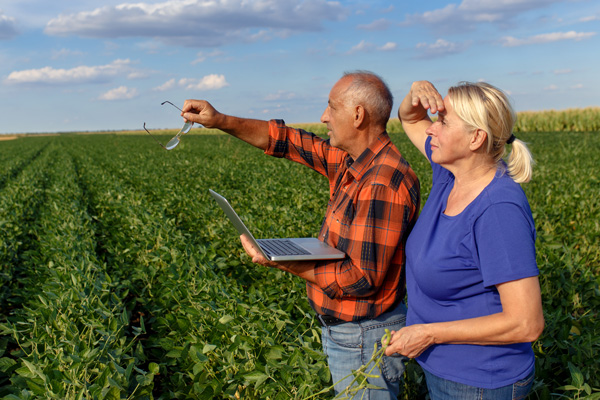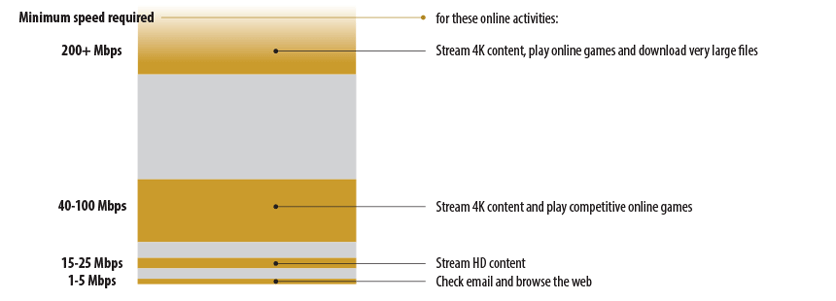Texas’ Digital Divide The State of Broadband in Texas’ Rural Communities
More than 2 million Texas households don’t have high-speed internet. While most of our city dwellers can access broadband, even urban Texas has pockets without it; Laredo and Brownsville hold the top two spots on a list of the nation’s worst-connected cities (PDF).

But Texas’ vast rural areas are especially underserved. As of 2016, only 69 percent of rural Texans could access high-speed internet (Exhibit 1). This digital divide has serious implications for education, telemedicine, agriculture and small business. But recent state legislation, federal funding programs and grassroots efforts may help Texans — and particularly rural Texans — get connected.
Broadband refers to always-on, high-speed internet access, whether obtained through cable, fiber, wireless, satellite or digital subscriber line (DSL). Internet speed is measured in megabits per second (Mbps). Regardless of provider, broadband speeds differ depending on peak use times (for example, right after work), number of connected devices (computers, smartphones and tablets) and the kinds of material being accessed (email vs. video, for instance).
The Federal Communications Commission’s (FCC) benchmark for high-speed internet is at least 25 Mbps for downloads and 3 Mbps for uploads. The commission’s 2019 Broadband Deployment Report found 21.3 million Americans lack access to broadband. Connected Nation Texas, the Texas branch of a national public/private initiative that promotes the spread of broadband, puts the number even higher, at 24 million.
EXHIBIT 1: INTERNET COVERAGE FOR TEXAS COUNTIES, 2016
Source: Federal Communications Commission
General Speed Requirements for Online Activities
The website Broadband Now offers these general speed requirements for online activities: 
Minimum speed required for these online activities
- 200+ Mbps: Stream 4K content, play online games and download very large files
- 40-100 Mbps: Stream 4K content and play competitive online games
- 15-25 Mbps: Stream HD content
- 1-5 Mbps: check email and browse the web
Texas-Sized Roadblocks
Each part of Texas “has its own topography and nuances,” says Bill Hetherington, CEO of the Bandera Electric Cooperative (BEC). “Our members are in the Hill Country, so terrain is an issue for us. Wireless technology just doesn’t work for us, because of limestone rock and houses on hills.” BEC provides broadband over fiber cable; “Electric co-ops near the Dallas-Fort Worth metro, where it’s flat, are pursuing more high-speed wireless [connections],” he says.
But supply and demand also play a big role. “The business equation for internet service providers to build out in low-population density areas isn’t there,” says Chris Pedersen, Connected Nation’s vice president for development and planning. “To invest hundreds of thousands of dollars to deploy infrastructure to [a few] households or businesses — there’s no return on investment.”
Economic Impacts of Broadband
Several facets of rural economies — health, education, agriculture and business — are becoming increasingly dependent on internet access.
Telemedicine: According to the State Office of Rural Health, 64 Texas counties lack a hospital and 25 don’t have a single primary-care physician. Telemedicine — the use of online disease management services, electronic health records, home monitoring and other services — can reach Texans who don’t have easy face-to-face access to healthcare.
While several pilot telemedicine programs have launched in rural Texas, a lack of reliable broadband service can hamper their success. The Texas Rural Health and Economic Development Advisory Council (PDF) has noted that some rural hospitals use multiple telemedicine platforms on different dedicated broadband links to connect to remote medical facilities or physicians. Roadblocks to broadband can increase telemedicine’s costs and limit its growth.
Agriculture: Today’s farmer depends as much on technology as any stockbroker or banker. Autonomous machinery, data-driven irrigation sensors and web-enabled sales platforms are just a few of the 21st century tools behind the scenes of modern “precision” agriculture, which applies high-tech processes to improve the efficiency and effectiveness of planting, nutrient and pest management and harvesting. The benefits drop off considerably, however, when internet service is unreliable.
A 2019 U.S. Department of Agriculture (USDA) report on farm technology, A Case for Rural Broadband (PDF), noted that of Texas’ nearly 247,000 farms, 25 percent have no internet access at all (Exhibit 2). USDA estimated that adequate broadband infrastructure and other digital technologies in agriculture could add from $47 billion to $65 billion annually to the U.S. economy, generating benefits equivalent to nearly 18 percent of the nation’s total 2017 agricultural production.
EXHIBIT 2: GROWTH IN INFORMATION TECHNOLOGY USE ON TEXAS FARMS, 2013-2019
*NA 2013 & 2015
Source: U.S. Department of Agriculture
Education: Texas has more schools in rural areas than any other state. The Classroom Connectivity Initiative, a public-private partnership seeking to increase access to affordable broadband for Texas’ public schools, says nearly 275,000 Texas students need more bandwidth for digital learning.
Limited broadband access often leads to a “homework gap” — the lack of home internet access can prevent students from completing their homework once they leave school.
More importantly, today’s students need to be technologically equipped for success in tomorrow’s workforce. Pew Research Center surveys report that Americans without broadband find themselves at a disadvantage in finding and applying for jobs and gaining new career skills.
To close the gap, students often create “workarounds” to connect with online resources, such as gathering outside businesses and school campuses to tap free Wi-Fi. Hetherington says Bandera students were often seen waiting in line at the Bandera County Library after school to use its high-speed internet. Today, Bandera ISD’s BEC-provided Wi-Fi has been incorporated into its curriculum; for example, Alkek Elementary students take iPads down Main Street on digital “scavenger hunts” to hone their online skills. Texas school districts such as Huntsville ISD and South Texas ISD have outfitted school buses with Wi-Fi so students can study during the ride home, while Weatherford ISD has provided signage and even recycled hardware for local businesses that want to offer students free internet access.
Broadband technology also is key to the use of online or “distance” learning, used by many colleges and universities to expand their course offerings and to allow students to pursue college degrees from home. In a recent report (PDF), nonprofit Bellwether Education Partners noted that rural students often face challenges due to geographic isolation and low-income backgrounds; distance learning can help them “engage with the broader community and gain exposure to new ideas.”
Staying Connected — Safely
Children, seniors and other groups are especially vulnerable to the dangers of “oversharing” online.
The University of Texas at Austin’s Center for Identity (identity.utexas.edu), which focuses on identity management, privacy and security, has valuable information on online threats and responses. It also offers tips to help parents of young children safely navigate the internet, as well as suggestions for senior citizens to avoid identity theft.
Business and tourism: When rural communities fade, can broadband help reverse the pattern? The U.S. Chamber of Commerce and Amazon partnered to find out, surveying more than 5,000 rural small businesses nationally about the impact of online tools and technology.
Digital technologies anchored by high-speed internet can help rural small businesses generate sales, expand their reach in the global marketplace and make purchases from larger vendor networks. The joint report estimated that increased access to digital tools over three years could generate nearly $6.7 billion in increased annual sales for rural Texas businesses, while creating more than 23,000 additional Texas jobs (Exhibit 3).
EXHIBIT 3: TEXAS’ RURAL SMALL BUSINESSES:
ECONOMIC IMPACT OF INCREASED ACCESS TO DIGITAL TOOLS
Texas' Rural Small Businesses: Economic Impact of Increased Access to Digital Tools
- $6.657 billion in annual sales
- 23,433 jobs
- $3.760 billion in annual value added
- $962.7 million in annual wages

Sources: U.S. Chamber of Commerce and Amazon
Tourism also sees positive economic impacts from broadband. In Bandera, “We first implemented free Wi-Fi in our business district to accommodate summer tourists,” Hetherington says. “These include Europeans who visit our town hoping to see a real cowboy — they don’t have U.S. data plans, so Wi-Fi was a must.
“We now have a Best Western, a Tractor Supply Company — businesses that rely on the ability to access high-speed internet,” he adds. Since expanding Wi-Fi coverage, “Bandera business owners have told me anecdotally they see a higher volume of people in their stores and people stay longer, meaning there’s a better chance they’ll buy something.”
Finding Solutions
Both grassroots efforts and established funding programs are helping rural Texans bridge the digital divide. Today, electric cooperatives across the state and nation have taken up the mantle for broadband access, much as they did during the country’s rural electrification of the 1930s. Once BEC members began asking for broadband, Hetherington conducted an online survey to gauge interest and determine the areas of greatest need.
“It’s a very surgical deployment, and it has to be done in a financially prudent way — if I’m putting in fiber for an electric system, I can also provide high-speed internet via fiber,” Hetherington says, referring to a “dig once” solution often used by co-ops and other utilities. To date, BEC has provided broadband internet to about 60 percent of nearly 6,000 members who expressed interest.
Connected Nation Texas has created a Texas Broadband Funding Guide (PDF) with input from statewide listening tours. “Using that feedback, we developed a guide that quickly helps users identify whether their projects are eligible for funding, along with examples of projects that have been implemented across Texas,” says Pedersen.
Several federal agencies offer funding for community broadband projects. USDA’s Rural Utilities Service, for example, offers more than $700 million annually for infrastructure loans that can be used to provide or enhance broadband services to certain communities. USDA also provides broadband grants and loans to create private-public partnerships focused on distance learning and telemedicine.
The FCC’s Connect America Fund recently allocated nearly $77 million in funding to bring broadband to unserved rural homes and businesses in 89 Texas counties. The commission’s next potential funding stream may be its proposed Rural Digital Opportunity Fund, which, if approved, would make available $20.4 billion over a 10-year term, targeting support to areas without broadband. (At this writing, the FCC is responding to comments from interested parties.)
In Texas, new laws from the 2019 legislative session may bring further attention to the digital divide. House Bill 1960 establishes the Governor’s Broadband Development Council, whose members will represent various stakeholders and areas of expertise, to research the progress of broadband development and identify barriers to deployment in underserved areas. HB 2422 requires the Texas Department of Transportation to provide online notice of certain highway construction projects so broadband providers can explore joint trenching opportunities. And Senate Bill 14 allows electric co-ops to use existing easements for broadband and fiber.
While proud that BEC has become known for bridging the digital divide in Texas, Hetherington says, “Everyone in rural areas is trying to figure out the ‘secret sauce’ to improving the economy in their region.” Broadband is an important part of that equation. “It’s no longer a luxury, it’s a necessity,” he says. FN
